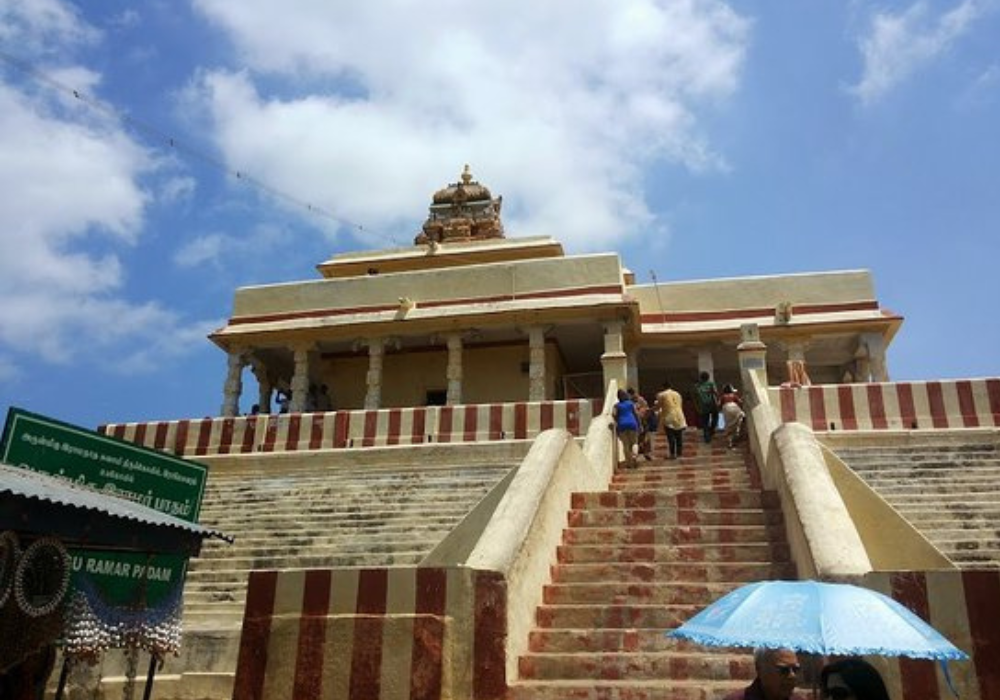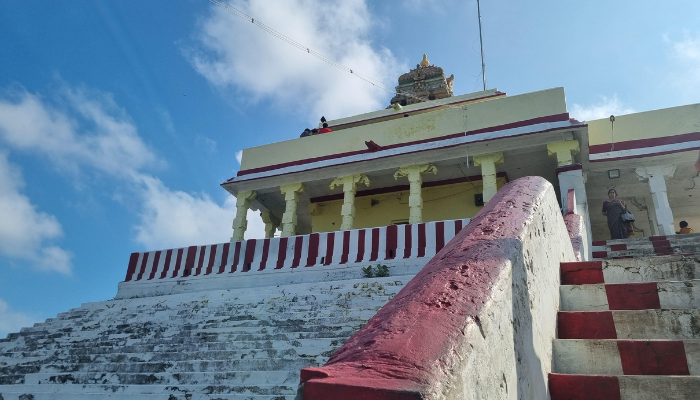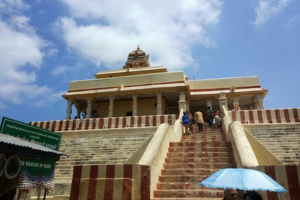
Embark on a spiritual and historical adventure to the revered Ramar Padam Temple, a significant pilgrimage site nestled in the holy town of Rameswaram, Tamil Nadu. This ancient shrine, often referred to as Gandhamadhana Parvatham, holds immense importance for devotees across the globe. It is believed to enshrine the sacred footprints of Lord Rama, marking a pivotal moment in the epic Ramayana. Our comprehensive guide will delve into the rich history, architectural beauty, and spiritual essence of the Ramar Padam Temple Rameshwaram, ensuring you gain a deep understanding of this divine destination. Furthermore, we will explore its connection to the larger Rameswaram pilgrimage, offering insights for a truly enriching visit to the Rameshwaram temple Ramar Padam complex.
History and Significance of Ramar Padam Temple

The Ramar Padam Temple boasts a history deeply intertwined with the ancient Hindu epic, the Ramayana. This sacred site is not merely a place of worship; it is a living testament to the legends of Lord Rama. According to revered traditions, this was the highest point in Rameswaram during ancient times. From this elevated vantage point, Lord Rama is said to have surveyed the sea towards Lanka, meticulously planning his journey to rescue Goddess Sita from the clutches of the demon king Ravana.
The Legend of Rama’s Footprints
The most compelling feature of the Ramar Padam Temple is the belief that it houses the actual footprints of Lord Rama. These revered impressions are preserved on a chakra-like stone within the temple’s sanctum. This sacred relic draws countless devotees who come to pay homage and seek divine blessings. The presence of these footprints symbolizes Lord Rama’s presence and his monumental journey. Additionally, legend states that it was at this very spot that Lord Hanuman returned from Lanka. He conveyed the crucial news of Goddess Sita’s discovery to Lord Rama, making this a site of profound mythological significance.
Spiritual Importance
The spiritual atmosphere at Ramar Padam Temple is profoundly serene, fostering a deep sense of devotion and contemplation. Pilgrims visit this temple to connect with the divine narrative of the Ramayana and to experience the spiritual energy of Lord Rama. It serves as a powerful reminder of faith, perseverance, and the triumph of good over evil. Many believe that offering prayers here can bring divine protection and guidance into their lives. The peaceful environment makes it an ideal spot for meditation and reflection, allowing visitors to immerse themselves in spiritual tranquility.
Architectural Marvels of Ramar Padam Temple

The architecture of the Ramar Padam Temple showcases traditional South Indian design, reflecting the rich cultural heritage of the region. While the temple is relatively small compared to some of the grander structures in Tamil Nadu, its design is imbued with spiritual meaning and historical context. Situated atop a sandy hillock, also known as Gandhamadhana Parvatham, the temple itself is a two-story structure. Its light yellow exterior with subtle red stripes adds to its unique charm.
Dravidian Architecture Elements
Though not as ornate as some larger temples, the Ramar Padam Temple incorporates elements characteristic of Dravidian architecture. These include intricate carvings and detailed sculptures that often depict scenes from the Ramayana. The layout of the temple is designed to facilitate worship and reflection, guiding devotees through a sacred experience. The simplicity of the sanctum, where Lord Rama’s footprints are enshrined, underscores the profound spiritual significance of the site, rather than relying on elaborate ornamentation.
Unique Structure and Panoramic Views
A notable feature of the Ramar Padam Temple is its elevated position. Visitors must climb approximately 25 steps to reach the main temple. This ascent is rewarded with breathtaking panoramic views of the entire Rameswaram island. From the upper floor or terrace of the mandapam, one can witness a mesmerizing vista that includes the vast expanse of the sea, the iconic Pamban Bridge, the Dhoordharsan Tower, and even the Ramanathaswamy Temple. This commanding viewpoint makes it a popular spot for photography and for simply soaking in the natural beauty and spiritual ambiance of the area.
The Pilgrimage Experience: Visiting Ramar Padam Temple Rameshwaram
Visiting the Ramar Padam Temple Rameshwaram offers a unique and serene pilgrimage experience. Thousands of devotees and tourists alike include this sacred site in their Rameswaram itinerary. The journey to the temple itself can be quite peaceful, especially if you choose to walk through the surrounding forests and rural settlements. Upon arrival, visitors are greeted by a tranquil environment that encourages prayer and meditation.
Best Time to Visit
The temple is open daily, generally from 7:00 AM to 1:00 PM and then from 3:00 PM to 6:00 PM. It is advisable to visit early in the morning or during sunset hours. These times offer cooler temperatures and particularly stunning views of the surrounding landscape. While the temple may not be as crowded as the main Ramanathaswamy Temple, it still attracts a steady stream of visitors throughout the year.
How to Reach
The Ramar Padam Temple is conveniently accessible from the main town of Rameswaram. It is situated on Pamban Island, approximately 2.5 to 3 kilometers from the Ramanathaswamy Temple. You can easily reach the temple by hiring a local auto-rickshaw or taxi. For those arriving by train, the Rameswaram Railway Station (RMM) is well-connected to major Indian cities. The temple is just a short drive from the station. If you are traveling by air, the nearest airport is Madurai International Airport, which is approximately 163 to 180 kilometers away. From Madurai, you can take a bus, train, or taxi to Rameswaram.
Darshan and Offerings
Upon reaching the temple, devotees can take darshan, which refers to the act of beholding the sacred idol or footprints. The Ramar Padam Temple enshrines the revered footprints of Lord Rama, allowing pilgrims to offer their prayers and seek blessings. It is important for visitors to note that photography is generally not permitted inside the temple, especially in the areas where the sacred footprints are kept. This rule ensures the sanctity of the shrine and allows for a more focused spiritual experience. While basic amenities like resting spots are available, facilities might be more limited compared to larger temples. Engaging with local devotees can also enrich your visit, providing insights into their traditions and practices.
Ramar Padam and Its Connection to Rameswaram Temple Ramar Padam
The Ramar Padam temple Rameshwaram is an integral part of the larger pilgrimage circuit in Rameswaram. While the Ramanathaswamy Temple is the primary draw, being one of the twelve Jyotirlingas and a Char Dham site, the Ramar Padam Temple serves as a crucial complementary destination. Many pilgrims consider their visit to Rameswaram incomplete without experiencing the serene ambiance and historical significance of Ramar Padam.
A Sacred Circuit
Pilgrims often visit the Ramar Padam Temple after their darshan at the main Ramanathaswamy Temple. This sequence allows for a holistic spiritual journey, connecting various significant sites associated with Lord Rama and Lord Shiva. The proximity of Ramar Padam to the main temple, just a few kilometers away, makes it an easily accessible and logical next step in the pilgrimage. The combined experience deepens one’s understanding of the rich mythological tapestry that defines Rameswaram.
Complementary Spiritual Journeys
Temple connection highlights the multifaceted spiritual appeal of the island. The Ramanathaswamy Temple represents devotion to Lord Shiva, while Ramar Padam emphasizes the legends of Lord Rama. Together, they offer a comprehensive spiritual narrative. This synergy allows visitors to explore different facets of Hindu mythology and spirituality within a relatively small geographical area. Therefore, including both temples in your itinerary provides a richer, more complete pilgrimage experience.
Nearby Attractions and Things to Do
Beyond the spiritual solace offered by the Ramar Padam Temple, Rameswaram is brimming with other fascinating attractions and experiences. The town itself is an island, connected to the mainland by the engineering marvel of the Pamban Bridge. Exploring these nearby sites can significantly enhance your trip to this sacred destination. There is no shortage of historical, natural, and cultural wonders to discover.
Agni Theertham
Located near the Ramanathaswamy Temple, Agni Theertham is a sacred beach. Pilgrims traditionally take a holy bath in its waters before entering the main temple. This ritual bath is believed to cleanse one of sins. The serene beach also offers stunning views of the sea, providing a peaceful atmosphere for reflection and spiritual purification. It is a significant starting point for many devotional journeys in Rameswaram.
Dhanushkodi
Known as the “Ghost Town,” Dhanushkodi is an uninhabited village with a poignant history. It was devastated by a cyclone in 1964. Despite its tragic past, Dhanushkodi remains a place of immense beauty and historical significance. It is believed to be the starting point of the Ram Setu, the legendary bridge built by Lord Rama’s army to reach Lanka. Visitors can explore the ruins and enjoy the pristine beaches where the Bay of Bengal meets the Indian Ocean. It is approximately 20 to 20.8 kilometers from the Ramar Padam Temple.
Pamban Bridge
The Pamban Bridge is an engineering marvel that connects Rameswaram Island to the Indian mainland. It consists of both a rail bridge and a road bridge, offering spectacular views of the turquoise waters below. Driving or taking a train across this bridge is an experience in itself, providing panoramic vistas of the surrounding seascape. It is a testament to human ingenuity and a popular spot for photography.
Other Notable Places
Rameswaram also offers other sites of interest. The Kothandaramaswamy Temple, located en route to Dhanushkodi, is another significant shrine associated with the Ramayana. It is believed to be the place where Lord Rama met Vibhishana, Ravana’s brother. Additionally, visitors can explore the Dr. A.P.J. Abdul Kalam Memorial, a tribute to India’s former President and renowned scientist, which showcases his life and achievements. The Panchmukhi Hanuman Temple, known for its floating stones, is also a popular stop for devotees. These diverse attractions ensure a well-rounded and engaging visit to Rameswaram.
Preserving the Legacy: Conservation Efforts
The preservation of ancient temples like the Ramar Padam Temple is crucial for maintaining India’s rich cultural and spiritual heritage. While specific detailed information on ongoing conservation projects for **Ramar Padam Temple** itself might be limited in public records, efforts are generally made to maintain such historical structures. Temples are living entities, and regular upkeep is essential to prevent decay and preserve their splendor. This typically involves structural repairs, cleaning, and sometimes repainting, ensuring the original character of the temple is respected.
The management of sacred sites often falls under various trusts or government bodies. For instance, the temple in Rameswaram is reportedly under the management control of the Ramanathaswamy Temple. This suggests a coordinated approach to the preservation of significant religious sites within the region. Such oversight helps ensure that the temple remains accessible and well-maintained for future generations of pilgrims and visitors. Furthermore, local communities and devotees often play a vital role in the informal upkeep and cleanliness of these revered places. Their collective efforts contribute significantly to the longevity and sanctity of the temple.
Moreover, the continuous flow of tourists and pilgrims also indirectly supports conservation. Their visits generate revenue, which can be reinvested into the temple’s maintenance and restoration. Therefore, by visiting the temple, you are not just experiencing history and spirituality; you are also contributing to its ongoing preservation. Awareness about the temple’s historical and mythological significance further encourages respectful visitation and responsible tourism practices. This helps protect the delicate balance of ancient structures and their natural surroundings.
Frequently Asked Questions (FAQ) about Ramar Padam Temple
What is the main significance of Ramar Padam Temple?
The Ramar Padam Temple is highly significant because it is believed to house the sacred footprints of Lord Rama on a stone. This site is also where Lord Rama observed Lanka and planned the construction of the Ram Setu to rescue Sita. Furthermore, it is believed that Lord Hanuman informed Lord Rama of Sita’s location here.
Where is Ramar Padam Temple located?
The Ramar Padam Temple is located on Gandhamadhana Parvatham, a sandy hillock in Rameswaram, Tamil Nadu, India. It is situated on Pamban Island.
What are the visiting hours for Ramar Padam Temple?
The Ramar Padam Temple is generally open from 7:00 AM to 1:00 PM and then from 3:00 PM to 6:00 PM daily. However, it is always a good idea to check local timings before your visit.
Can I take photos inside the Temple?
No, photography is typically not allowed inside the Temple, especially in the areas where the sacred footprints are kept. This rule helps maintain the sanctity and spiritual atmosphere of the shrine.
Is Ramar Padam Temple the highest point in Rameswaram?
Yes, the Ramar Padam Temple is situated on Gandhamadhana Parvatham, which is considered the highest natural point or highest altitude in Rameswaram. This elevated location offers incredible panoramic views of the entire island.
How far is Ramar Padam Temple from the main Ramanathaswamy Temple?
The Ramar Padam Temple is approximately 2.5 to 3 kilometers away from the main Ramanathaswamy Temple in Rameswaram. It is easily accessible by local transport.
What makes the Temple a must-visit in Rameswaram?
This temple is a must-visit because of its profound mythological connection to the Ramayana, housing Lord Rama’s footprints. Moreover, its hilltop location offers breathtaking panoramic views of Rameswaram and the surrounding sea, providing both spiritual enrichment and scenic beauty.
Are there other Ramar Padam temples in Tamil Nadu?
Yes, in Tamil Nadu, there are believed to be three places referred to as Ramar Padam where Lord Rama’s footprints are preserved. The one in Rameswaram on Gandhamadhana Hill is one of them. The others are near Vedaranyam and near Theerthadanam.
Conclusion
The Ramar Padam Temple in Rameswaram stands as a profound testament to faith, history, and natural beauty. This sacred shrine, perched atop the highest point of the island, offers a unique blend of spiritual solace and breathtaking panoramic views. Its deep-rooted connection to the epic Ramayana, particularly the belief that it houses Lord Rama’s sacred footprints and was a pivotal planning site for the Ram Setu, draws pilgrims and history enthusiasts from all corners of the globe.
A visit to the Ramar Padam temple Rameshwaram is more than just a sightseeing trip; it is an immersive experience that allows you to walk in the footsteps of legends. The peaceful atmosphere, combined with the stunning vistas of the Pamban Bridge and the vast ocean, creates an unforgettable spiritual journey. Furthermore, its close proximity to the renowned Ramanathaswamy Temple makes it an essential part of any comprehensive Rameswaram pilgrimage.
By exploring the Rameshwaram temple Ramar Padam site, you connect with centuries of devotion and an enduring cultural legacy. It serves as a powerful reminder of ancient tales and their timeless lessons. Whether you seek spiritual enlightenment, a deeper understanding of Indian mythology, or simply a tranquil escape with spectacular views, the Ramar Padam Temple promises a truly enriching and memorable experience. Therefore, make sure to include this hidden gem on your travel itinerary to Rameswaram. You will discover a place where divinity meets natural splendor, leaving you with lasting impressions of peace and wonder.

Binu Lamba
Binu Lamba is a 29-year-old editor and fact-checker with 7 years of experience in travel content. He verifies all location details, hotel recommendations, and travel tips to ensure our guides are accurate, updated, and helpful for readers planning real trips.

AI Assistant
Our AI writing assistant supports the creation of travel content under strict human supervision. All AI-generated posts are thoroughly reviewed, fact-checked, and updated by our team to maintain trust and accuracy in our travel recommendations.

Discovering the Sacred Ramar Padam Temple in Rameshwaram
Located in Rameswaram, the Ramar Padam Temple is believed to mark the spot where Lord Rama’s footprints are imprinted. Set atop a hillock, it offers a spiritual and scenic experience in one visit.

“How to Reach Hyderabad – By Flight, Train, or Bus”
If you’re planning a trip and wondering how to reach Hyderabad, this guide will help you find the best travel options. Hyderabad is a major

“How to Reach Mumbai – Travel Guide by Flight, Train, and Bus”
If you’re planning a trip and wondering how to reach Mumbai, this guide covers all your travel options. Mumbai is one of India’s major cities








